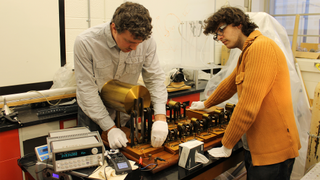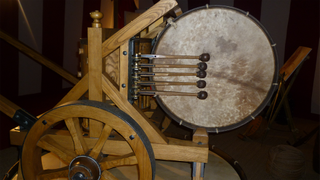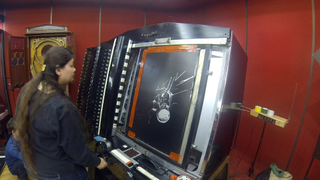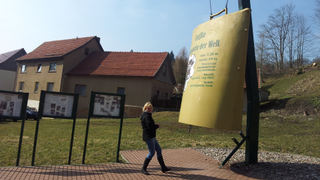Meet Pepe Deluxé, the duo on a quest to make music with the world's strangest instruments
Featuring on their latest album: a synth designed for group sex, a sacred Tibetan drum made from human skin and bone, and the world's largest cowbell

We've seen some unconventional instruments in our time here at MusicRadar, but nothing quite like the collection amassed by Pepe Deluxé, a duo devoted to seeking out the world's strangest instruments, rare synthesizers and eccentric music-making devices.
Formed in 1996 with a wider line-up, the group produced big beat and downtempo throughout the '00s, culminating in the 2012 oddball pop opera Queen of the Wave. Almost a decade later, they're back with their magnum opus, a documentation of their search for unusual, unknown and unbelievable instruments from museums, universities and private collections around the world.
The album credits for Phantom Cabinet Vol. 1 reads like an inventory list for an incredible musical instrument museum: as far as synths go, they've got the Helmholtz, the world's oldest synthesizer, the ANS, a Soviet-era behemoth designed to transform images into sound, and the Knifonium, the world's first tube synthesizer, notably used by Hans Zimmer for the Interstellar soundtrack. And that's before we've even mentioned the Sexophone, a synth that's intended to be hooked up to the human body, producing sound using the bio-feedback generated by... well, we think you can guess.
Elsewhere in this madhouse of an album, you can find ancient drums made from a human skull, the pyrophone (an instrument that uses flames as an oscillator), the world's largest cowbell, viking folk horns and the Great Stalacpipe Organ, a mammoth instrument built inside a cave that plays real stalactites. Understandably, we had some questions for James Spectrum and Paul Malmström, the pair of musical adventurers behind Pepe Deluxé...
Talk to us about your new album - where did the initial idea for this concept come from?
“We’ve always been interested in strange sounds and unusual recording, that goes back to the very beginning of Pepe Deluxé - crate digging and sampling obscure records. But about ten years ago, when we were working with the largest musical instrument in the world, The Great Stalacpipe Organ (located deep down underground in Luray, Virginia), a light bulb went on in our brains.
The Sexophone is an instrument for two or more performers, who are connected to the central unit with handcuffs and wires [...] the more moist the "contact points" are, the more exciting sounds Sexophone creates
"If tens of millions of people had seen and heard The Stalacpipe, yet not a single person had seen it as a musical instrument and composed a song for it… what other hidden musical gems were out there for us to unearth?”
Get the MusicRadar Newsletter
Want all the hottest music and gear news, reviews, deals, features and more, direct to your inbox? Sign up here.
What other musicians or artists have inspired this record and the concept behind it?
“Oh, THAT list would fill a phone book (big books of phone numbers we had when dinosaurs still roamed the earth!) We are really inspired by the sounds and music of the golden era of vinyl records, from the late ‘50s to mid ‘70s. And of course some later stuff too! We’re not particularly interested in trying to replicate music of the past; we’re just borrowing plenty of weird and wild ideas, and developing them further.”

How did you discover all of these different instruments - I imagine a lot of research went into this aspect?’
“The original plan was to record perhaps a few very unusual instruments, but the thing started expanding very quickly - which is very typical for us! New contacts helped us to find new contacts, and once we got going, it was … well, it was a collector’s obsession to find that “just one more” instrument!
It’s a sacred Tibetan instrument that is made from a human male and a female skull bone
“And you are absolutely right: a lot of research, a lot of detective work, and many dead ends. In some cases it took years to proceed from the initial contact to the actual recording session.”
What was your favourite of the instruments you used for this record?
“Ah, that’s a really difficult one! After The Stalacpipe we simply couldn’t be totally blown away by anything. But I must say the Moscow session was quite something. Recording God’s own Trumpet (a drawing by William Blake) with the revolutionary and mystical Soviet images-to-sounds synthesizer ANS! We were a bit worried that it might kick off the Biblical end of the world. But one has to take risks in the name of art, right? RIGHT?”
Could you tell us about two or three more instruments that you really loved using, or that have an interesting backstory?
“There are so many instruments on the album with fascinating stories! For example we spend a lot of time looking for a Skull Damaru we could record. It’s a sacred Tibetan instrument that is made from a human male and a female skull bone. They are cut well above the area of the ear, and joined at their apex. The drum heads are also made of human skin. After several responses of “sorry, not possible!”, we finally managed to find and record one at a private museum in South Africa.
The album also contains sounds like my younger daughter’s birth scream, a huge pneumatic hammer, a mosquito singing in the right key and “drum kit” made of the sounds of a sauna
“Another example and actually a brand new instrument is musician-composer Lauri Porra’s Omniwerk. It combines the Viola Organista (violin organ), originally invented by da Vinci in the late 15th century, with a Lautenwerk lute-harpsichord – Bach’s fave instrument. It can sound wonderful, terrible, beautiful, menacing… a beautiful instrument that is not easy to play. A great example of ideas of the distant past taken into the future.”
Which instrument had the most unexpected sound?
“That must be the largest cowbell in the world! We’ve all seen the Saturday Night Live’s “More Cowbell” skit, and we simply had to have The Most Cowbell Ever. We found it in Germany, built by Venter-Glocken, a family-run company that has been building cowbells since 1874. When we heard the sound of this one-tonne monster, we were first like “erm, is THAT it?!” It IS a cowbell, just tuned very, very low.”

On the other end of the spectrum - do you have a least favourite? Any that were particularly difficult to use or get a good sound out of?
“Ah, to us there is no such thing as a “bad” sound – it’s like saying some color is “bad”. It all depends on the context. But you have to understand that many of the instruments we recorded were really old and some had not been played in decades or even in over a century.
"Many were fragile museum objects in less than an optimal condition, and they were to be treated extremely carefully. We had to do plenty of restoration, tuning and sound replacing to the sounds before they could be used for actual music work.”
Tell us about the Sexophone, the 'synth designed for group sex'?
“The DIMI-S aka “Love Machine” aka “Sexophone” is a result of a collaboration between a Swedish electronic music pioneer Ralph Lundsten and Finnish visionary synth builder Erkki Kurenniemi, who developed polyphonic digital synths years before Moog released the Minimoog!
“The Sexophone is an instrument for two or more performers, who are connected to the central unit with handcuffs and wires, and who can produce sounds by touching each other’s bare skin. The more moist the "contact points" are, the more exciting sounds Sexophone creates.”

Was it a challenge to create a cohesive sound for this record, considering how many different instruments and sounds you were using?
“Recording the instruments and editing the recordings required an insane amount of labor. But the actual compositional work with them and their sounds was relatively easy and extremely inspiring. Everyone who’s done any creative stuff knows the fact that new (old) toys are the next best thing after good ideas. It’s all about playing. And not only the music but some of the lyrics too are inspired by the instruments’ histories and stories.”
In addition to the variety of instruments used, talk to us about some of the recording processes or studio techniques on this record. Anything unconventional or interesting you could tell us about?
“To quote our good friend Mr. Fastfinger: “Thinking outside the box? I can’t even find the damn box anymore!” Probably one third of the gear at our Sanctum Sanctorum museum studio is very unusual or straight from the Twilight Zone. Everything from a 1920’s electromechanical amplifier to a studio version of Edison’s Ghost Box, an apparatus originally designed for detecting phantoms.”
Our records are more like sonic documentaries of our latest adventures than collections of songs written in order to create an album
“The drums recorded in the elevator – a large moving elevator, to be precise - was part of a much fun session where we had access to all the main parts of this huge old cable factory. We had an idea of creating a song’s rhythm track with drums that would transport the listener to various spaces of different sizes and materials.
“That idea slowly evolved into “Halls of Kalevala”, a song that features a narration by Cyrus Faryar – who was also the narrator on the world’s first synth rock album, 1967’s The Zodiac: Cosmic Sounds. It’s not only an album of incredible instruments; there are some incredible characters too!”

Aside from instruments, what unconventional sounds (environmental or found sounds) have you recorded and sampled for this album?
“I always travel with three things: my Moleskine notebooks, my camera and a portable recorder. And thanks to that the album also contains sounds like my younger daughter’s birth scream, a huge pneumatic hammer, a mosquito singing in the right key and “drum kit” made of the sounds of a sauna.”
“Pepe albums are not projects with a clear start or an ending. We are always developing and working on various music and art ideas, and our records are more like sonic documentaries of our latest adventures than collections of songs written in order to create an album.”



I'm MusicRadar's Tech Editor, working across everything from product news and gear-focused features to artist interviews and tech tutorials. I love electronic music and I'm perpetually fascinated by the tools we use to make it. When I'm not behind my laptop keyboard, you'll probably find me behind a MIDI keyboard, carefully crafting the beginnings of another project that I'll ultimately abandon to the creative graveyard that is my overstuffed hard drive.

“I didn’t even realise it had synthesizer on it for decades”: This deep dive into The Beatles' Here Comes The Sun reveals 4 Moog Modular parts that we’d never even noticed before

Is Sabrina Carpenter the world’s biggest Teenage Engineering fan? Please, please, please say that it’s true


![Chris Hayes [left] wears a purple checked shirt and plays his 1957 Stratocaster in the studio; Michael J. Fox tears it up onstage as Marty McFly in the 1985 blockbuster Back To The Future.](https://cdn.mos.cms.futurecdn.net/nWZUSbFAwA6EqQdruLmXXh-840-80.jpg)






